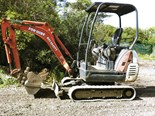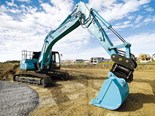Rongsheng Zhenyu ZY210SD4 review











|

|

|

|

|
Deals on Wheels checks out the Zhenyu ZY210SD4 floating excavator from Rongsheng Machinery—a 40-tonne amphibious earthmover with extraordinary abilities
There is an old saying: "When the going gets tough, the tough get going." And when it gets this tough, it is time to call in the big guns.
The Soil Conservation of New South Wales remediation of the Urunga mine site is a hugely important one.
It was previously used for processing stibnite (antimony ore), which released vast amounts of antimony, arsenic, and mercury in its treatment as well as cyanide and phenolic acids for treatment of antimony, which used vast amounts of arsenic in its treatment. And all this on a previously pristine waterway.
The collection of exciting and specifically designed earthmoving equipment required to complete the works on hand has been nothing short of remarkable.
The jewel in the crown of Newcastle-based MJ Latham Contracting is a Rongsheng Machinery Zhenyu ZY210SD4 amphibious or floating excavator, and it was generously entrusted to me for a few days so I could give it a good workout on this project.
On the job
Now, this machine is no ordinary run-of-the-mill amphibious craft. What makes this excavator just that bit different is that not only can it float in the middle of wetlands but also when it is all rigged up, its gross weight jumps from 36 tonnes to 40 tonnes, and it can run just about any hydraulic attachment you could imagine.
Murray Latham delivered his machine to the Urunga site about 12 months ago and has been a major contributor to the success of this project.
The task was not an easy one, as part of the scope was to remove and/or stockpile all of the dead melaleuca trees from the middle of the contaminated wetlands, install a sheet pile wall of some 600 lengths, desludge thousands of metres of contaminated sludge from the waterways, load out the toxic mud from the bottom of the wetland, which conventional plant could not access, and then come in and remove all of the 600 sheet piles while bobbing around in the middle of the lake. Now, I can guarantee this was no easy task and required a high standard of operational skills, personnel safety awareness, and a team of good lateral thinkers to make it a success.

The project was swamped with competent men the likes of Jason Bashforth, Steve Hammond, Jeff Lane, and of course, Murray Latham.
After the excavator cleared the dead trees with the bucket, a log grab was attached and used to stockpile the trees for load-out.
Once the area was cleared of debris and vegetation, an assessment was carried out to find the depth and extent of the toxic material located below the wetlands. And once again, the floating excavator changed hats. This time, the Zhenyu ZY210SD4 had to complete a wetland sheet piling operation to seal off the non-contaminated sector of the wetland and enable the excavation and desludging operations to start.
Once again, the floating excavator proved its versatility. Murray simply engaged the hydraulic sheet piling header to install the piles and then changed over to a hydraulic sludge pump to desludge the affected areas into specially constructed settling ponds closer to shore.
After these difficult stages were completed, work began on the seemingly simple task of excavating some of the 30,000 cubic metres of slush and contaminated mud.
Mud mats were created so the specialised mud and wet terrain equipment could haul the materials to the newly constructed mono cell, which would house the materials on site.
Hauling the toxic sludge was no mean task either, and all-terrain track drive Morooka MST-3000VD site dumpers proved to be an excellent choice for the movement of this type of material.
A Caterpillar D6R LGP swamp dozer and Heking HK150SD amphibious excavator from Floating Excavators in Queensland were bought in and utilised for placing and trimming the wet materials into some shape prior to capping and sealing.
Under the hood
The Rongsheng Machinery Zhenyu ZY210SD4 is a Chinese-manufactured machine. It is made in Hefei, a large heavy machinery manufacturing hub that also houses the Heking factory.
With the advent of Tier 4 engines being produced worldwide, there has been a significant dumping of the tried and proven naturally aspirated diesel engines into China.
These engines have been procured at rock-bottom prices and are perfectly suited to the amphibious craft due to the fact that they can be subjected to moisture intake. This is a win-win for the manufacturer and the buyer, as the price is kept to a minimum and provides more than adequate power to drive the pumps on this and many others units manufactured in Hefei.

This 10,000-hour machine runs a six-cylinder Isuzu intercooled turbo diesel engine, which pushes out about 150hp—ample for the tasks this machine undertakes and more than enough power to drive the Doosan hydraulic pumps and final drives as well as the long boom/short dipper specifically designed for this application.
In the cab
The cab is spacious and simply set out. Although the dash layout is in both Chinese and English, it still takes a bit to sort it out should you have an issue that needs to be addressed (based on personal experience). An aftermarket hydraulic oil temperature gauge is fitted and clearly sits front and centre for you to clearly view at every level of operation—imperative when operating some of the hydraulic attachments for long periods on hot days.
I found this particularly useful when those six-metre-long sheet piles were being firmly driven in to a clay base and during the extraction operation. This caused the hydraulic oil temperature to rise, but an aftermarket oil cooling system could be manually engaged to bring things back to normal.
To operate the 'spud' legs or piles, a set of diverter-valves have been fitted to the track drive hydraulics. This is the perfect position as the track drive is no longer in use once you are positioned to set your spuds in place when you are floating in deep waters.
Once in place, the spuds are driven into the underlying mud base to a depth of four metres and hold the machine firmly in place.
With the spuds engaged, they provided the stability required for forward and backwards support. This, along with the outrigger pontoons, provided an excellent, stable base for working in up to four meters of water. The vision was overall pretty good, but I did find it difficult to keep track of the six-metre-long sheet piles when extracting as they disappeared from view through the skylight in the roof.
Factory-fitted auxiliary hydraulic lines run the full length of the boom and dipper with a case drain line run back to the hydraulic tank for those larger attachments.
Compulsory AC, radio, two-way, HEPA air filter, flashing lights, E-stops, fire extinguishers, flotation vests, 360-degree grid mesh walkway, handrails and floating buoys all make up to the necessary items to keep this machine on site.
The verdict
With floating or amphibious excavators gaining acceptance and opening up access to areas once deemed completely inaccessible, it certainly makes the utmost sense for clients to consider them for difficult and once unobtainable objectives.
This project at Urunga is, in my opinion, sitting perfectly for an Earth Award this year. It could not have proceeded or succeeded without the use of both the floating excavators used here.
I would have to classify the Rongsheng Machinery Zhenyu ZY210SD4 as the 'Big Daddy of Floating Excavators', as it has performed brilliantly at every turn and completed tasks not seen before.
It had operators with the tenacity to overcome adversity, lateral thinkers to throw up innovative methods to achieve seemingly unobtainable goals, and the skills to extract the very best out of a machine working in the most difficult of terrains.
None of this set-up comes cheap. In fact, there are significant costs to keep the machine afloat.
High running costs, track chain, and track plate replacement, corrosion, and damage to hydraulic hoses and fittings, and (the killer) the intake of moisture into critical electronic and hydraulic components all take a toll on the overall profits one would hope to yield with such a rig.
Mobilisation costs are also significant, with the track drive pontoons, upper carriage, and each external floating pontoon all require separate trailers and/or low loaders to deliver to site. Plus, you need an 80–100-tonne crane to put the machine together and dismantle it.
With everything taken into account, I can only give this excavator the thumbs-up. I found it extraordinary and so successful in this application.
Just when you think you have seen and done it all, you find a machine like this.Well done, Murray Latham. I think another excavator evolution is well on the way.
Keep up to date in the industry by signing up to Deals on Wheels' free newsletter or liking us on Facebook.






